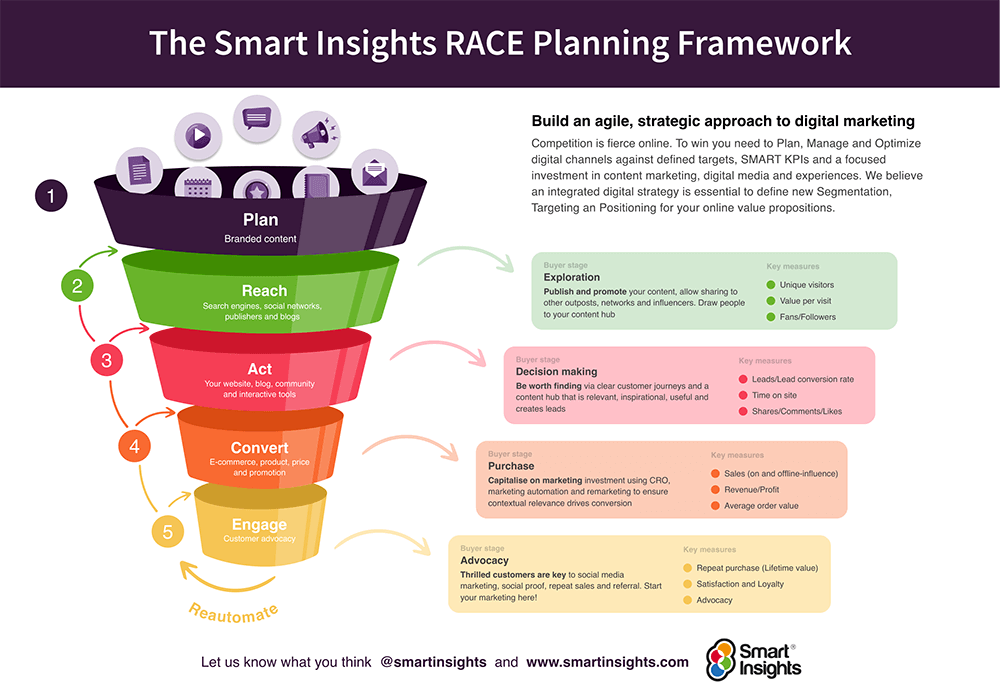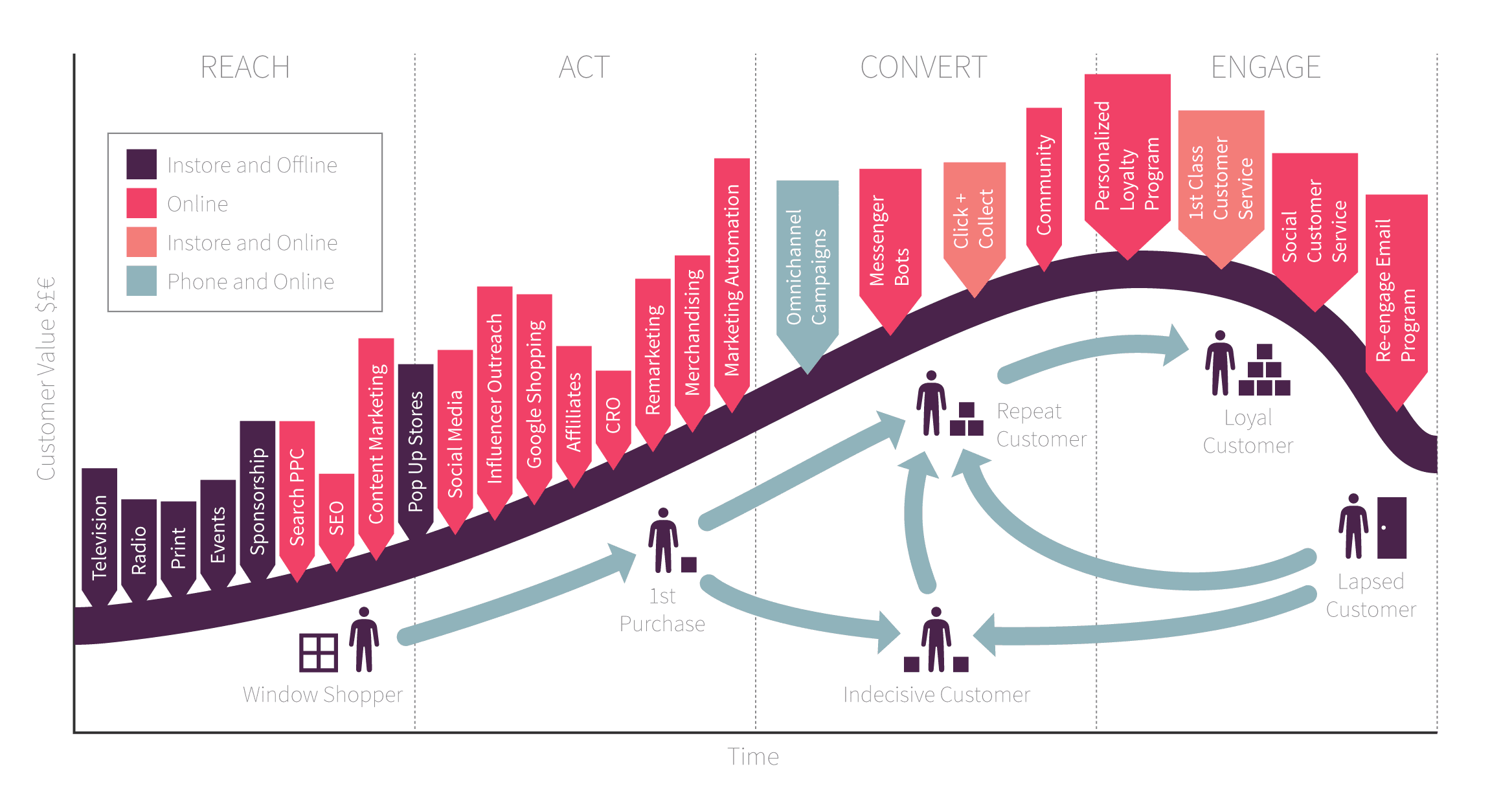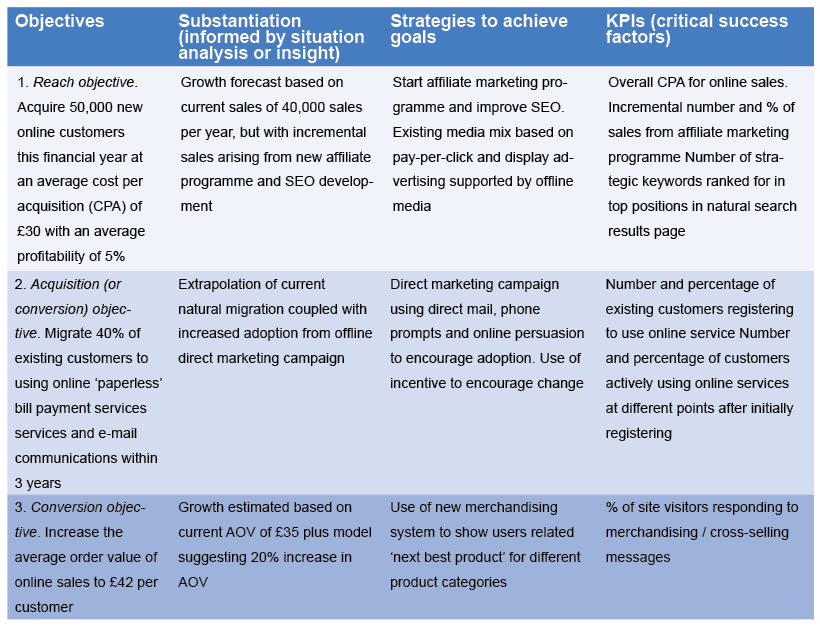An integrated marketing strategy means every element of your marketing plan must contribute towards your goals and objectives, or be cut out of the day-to-day workload
Lack of integration between strategic vision and the tactics needed to get there is a problem I often find when reviewing marketing strategies. That's why I created the RACE Framework as a simple structure to unify your marketing strategy through goals, objectives, and KPIs. You can see table with an example of integrated marketing goals and objectives planning below.
This is true whether I'm reviewing student assignments or mentoring marketers creating real-world marketing strategies. More often than not, I find myself reading about different aspects of marketing objectives and tactics that just don't line up with each other - and leave you questioning why.
These issues can be magnified by marketing strategy structure - the way the document is split up into separate sections. Without a unifying framework, it's not clear how each strategy is supporting a goal or the analysis on which the objective is based. You can read more about these issues in my article 10 reasons you need a digital marketing strategy.
If this sounds familiar, keep reading to see our recommended approach to overcome these common challenges.

What is digital marketing?
Digital marketing, also called online marketing or internet marketing, is defined by Dr. Dave Chaffey as:
"Achieving marketing objectives through applying digital media, data and technology".
The RACE Planning Framework
RACE is a practical framework to help manage and improve results from your digital marketing strategy. Ultimately, it’s about using a data-driven approach, gathering customer insights, and applying recommended best practices to get more commercial value from your investments in marketing.

Notice how we have defined five steps of engagement across the customer lifecycle, since in online marketing there is a major challenge in gaining initial interaction and creating those all-important leads after the initial customer touchpoint which can then be nurtured.
Taking an integrated approach to your marketing activities will support your goals of channeling customers through the funnel of PLAN, REACH to ENGAGE, by measuring and tracking the most important touchpoints for your business right now.
If you're looking for a new marketing plan structure that helps you integrate your marketing activities and prioritize channels that generate growth, why not download our free marketing plan template?
Free marketing plan template
Our popular marketing planning template is structured across the Smart Insights RACE Framework. Join Smart Insights as a Free Member to download your free template today
Access the Free marketing plan template
Integrated marketing goals and objectives example
The 4 example sections below, plus recommended templates, demonstrate how you can integrate objectives, substantiation, strategies, and KPIs.
1. Set objectives
SMARTER objectives are not a new concept in marketing. This means committing to quantified objectives that are specific, measurable, achievable, relevant, and time-bound. These are likely, grouped around customer acquisition, conversion, or retention. You can use the RACE Framework to help categorize these.
Business Members can use our set digital marketing goals and objectives module to improve goal/objective setting technique. See some examples of Smart marketing objectives below.
SMART marketing objectives examples:
- Increase online sales by 20% in six months through targeted digital campaigns and website optimization.
- Gain 50,000 new Instagram followers in one year to boost brand awareness.
- Reduce churn rate by 15% in the next quarter through personalized retention strategies.
- Grow website traffic by 30% in six months via SEO, content, and social media.
- Capture 10% of a niche market within a year through focused marketing efforts.
- Generate 25% more qualified leads in three months through targeted campaigns.
- Achieve an NPS of 50+ in six months by addressing customer feedback effectively.
- Reach $100,000 in sales within a month for a new product launch through comprehensive marketing.
- Enter three new markets within a year through research and strategic partnerships.
- Attain a 5% average engagement rate on social media within three months through interactive content and user campaigns.
2. Validate your plan/goals
Provide substantiation i.e. evidence proving that your plan is realistic based on situational analysis or by creating conversion models. Here are examples of substantiation sources you could use for the above examples.
- Increase online sales by 20% in six months:
- Substantiation: Market data and trends support potential growth via digital channels and optimization efforts.
- Gain 50,000 new Instagram followers in one year:
- Substantiation: Analysis of competitors and audience feedback indicate achievable growth.
- Reduce churn rate by 15% in the next quarter:
- Substantiation: Customer feedback highlights areas for improvement, and industry norms suggest attainable reductions.
- Grow website traffic by 30% in six months:
- Substantiation: Current traffic analysis and industry standards suggest realistic growth through targeted strategies.
- Capture 10% of a niche market within a year:
- Substantiation: Market research shows the niche's potential size and success stories validate similar targeting efforts.
- Generate 25% more qualified leads in three months:
- Substantiation: Analysis of current leads and conversion rates indicates potential gains through targeted campaigns.
- Achieve an NPS of 50+ in six months:
- Substantiation: Historical data and industry benchmarks support feasible improvements through enhanced customer feedback mechanisms.
- Reach $100,000 in sales within a month for a new product launch:
- Substantiation: Market analysis and past successes demonstrate the potential for rapid sales growth with a comprehensive launch strategy.
- Enter three new markets within a year:
- Substantiation: Research identifies viable markets, and successful precedents validate the feasibility of expansion.
- Attain a 5% average engagement rate on social media within three months:
- Substantiation: Current engagement metrics and industry examples suggest achievable growth through interactive content and user campaigns.
3. Strategies to achieve your goals
Outline the main ways you will reach your objectives. As a data-driven marketer, with informed objectives and substantiation, this is the part of your marketing plan that helps you put practice into action.
Our RACE Lifecyclye Marketing Model is a great visual technique for mapping each stage of your customers' experiences of your brand across RACE. As you can see below, each stage requires strategies that integrate in store and offline, online, in store and online, and phone and online.
Download our Free marketing plan template to align your marketing activities across RACE, and apply prioritization templates and frameworks to help identify your biggest opportunities for growth.
Free marketing plan template
Our popular marketing planning template is structured across the Smart Insights RACE Framework. Join Smart Insights as a Free Member to download your free template today
Access the Free marketing plan template

4. Integrated marketing plan
Key Performance Indicators and Critical Success Factors are the detailed measures, for example, those collected within Google Analytics or other platforms, which will help you review your performance. You can use this data to make adjustments - for e.g. if you find one journey/experience is more successful at generating particular behaviours/conversions which drive towards your goal.
Best practice when setting your objectives is to also agree how you will measure your success. You may use a RACE dashboard or similar to prove you're on track to meet your goals or make adjustments accordingly.
I recommend this grid layout from our digital marketing plan workbook for aligning your strategies with your objectives, since it provides a simple one to two-page summary of your marketing strategy. Much more effective than a long report your colleagues or clients won't read...

If you're ready to start aligning or optimizing your marketing strategy, don't miss our free downloadable RACE 90-day planning template and interactive planning grid. Unlock these and more when you become a Smart Insights Free Member.
Free marketing plan template
Our popular marketing planning template is structured across the Smart Insights RACE Framework. Join Smart Insights as a Free Member to download your free template today
Access the Free marketing plan template












